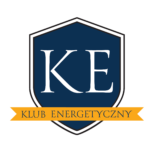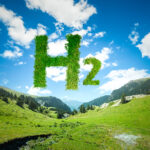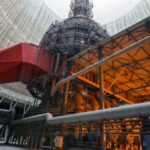Poland has the opportunity to become a leader in several niches of the hydrogen economy. Acceleration depends on regulation and support for infrastructure development.
Medicine and energy are the areas where the most groundbreaking discoveries are being made today," said Prof. Alojzy Nowak, Rector of the University of Warsaw, opening the conference. "I am convinced that many of these discoveries will be made by Polish scientists. I would like the hydrogen bus they have built to connect the University's buildings in Warsaw. However, for the time being, it would have a problem with refuelling.
Prof. Alojzy Nowak, Rector, University of Warsaw
Attendees of the ‘Hydrogen Economy Value Chain in Poland’ conference, which took place on 11 May 2023 in Warsaw, tried to answer the question of when hydrogen solutions will be at least as widespread as PV is today. In order for this to happen as soon as possible, there needs to be an acceleration in terms of regulation and state support in the area of infrastructure, as the technology is already there and Poland has the opportunity to become a European, or even global, leader in several niches of the hydrogen industry.
Find out more about the Hydrogen Conference:
Hydrogen niches of the future
Three products were presented at the conference with this opportunity:
- solid-oxide cells (SOCs) from the Institute of Power Engineering, which have already been used at the Elbląg CHP plant;
- SynGen reactor from mPower Green Tech – a mobile device for processing biomass and waste, generating electricity, heat and green hydrogen;
- thermoelectrolyser from Hydromeda Technologies, with a hydrogen production efficiency of 96%.
As Europe’s third and the world’s fifth producer of ‘grey’ hydrogen, we have a good business and technology base to play a significant role in this industry by switching to ‘green’ (zero- or low-carbon) hydrogen.
We should look for a niche that offers the opportunity to do something more effectively than others. The inventors of the first generators did not know in what direction the energy system would develop in 30-50 years' time. We need to think out-of-the-box about energy storage. In a sense, wine is a storage of grapes and cheese is a storage of milk. Although we are limited by our lack of knowledge, we know more and more.
Prof. Jakub Kupecki, Director, Institute of Power Engineering
The entire report "Hydrogen Economy Value Chain"
During the conference, the conclusions of the report were presented by one of its authors, Prof. Grzegorz Tchorek of the Institute of Power Engineering.
The EU has defined strict conditions for hydrogen to be considered low carbon / green, and only such projects will be subsidised. Our research shows that only the electrolysis of hydrogen using energy derived from renewable, i.e. from wind, solar or nuclear, meets the EU's taxonomy. Other methods, including coal gasification (+CCS), steam methane reforming, waste treatment, coal gasification and electrolysis using energy from the grid, will not be considered low-carbon by the EU.
Prof. Grzegorz Tchorek, Institute of Power Engineering
In addition to methods of hydrogen production, the report also includes a comparative analysis of issues relating to its use, storage, transmission and distribution.
Transportation as a flywheel
Germany, Korea and Japan are the leaders in terms of the number of registered hydrogen vehicles. Poland, with no publicly available infrastructure, has 150 registered hydrogen cars. And yet, the inclusion of transport in the ETS is ahead of us.
According to the AFIR regulation of March 2023, at least 49 hydrogen refuelling stations should be built in Poland by 2030. Meanwhile, the station in Rybnik will only be the second. The city has recently decided that it will be open to the public and not just for public transport as originally planned. This infrastructure is awaited by Toyota, which has been producing hydrogen cars for eight years.
Infrastructure required for H2 market development
We lack three elements: infrastructure, infrastructure and infrastructure. Electric car charging points are being set up at a rapid pace; there is even simplified legislation. It is time to roll out such a red carpet for hydrogen cars. It is good that there are subsidies for buses, but let's remember that PV took off thanks to end-user support. Passenger car subsidies would be a good boost.
Andrzej Szałek, Board Advisor, Toyota Central Europe
The expert pointed out that CO2 emissions of a car powered by grid-sourced hydrogen in Australia are 55 g/km. Meanwhile, the EU applies a standard of 95 g/km – the strictest in the world. For example, in Japan it is 120 g/kg and in the U.S. – 130 g/kg. If hydrogen produced using energy from the grid was used in Poland, the CO2 emissions of our hydrogen cars would be 120-200 g/km.
According to Christopher Dresler, director of hydrogen projects at Impact Clean Power Technology, hydrogen is complementary to lithium-ion batteries. This is because the cell will remain a balancing element allowing the amount of energy to be matched with demand. “We hope to follow a similar path with hydrogen as it happened with LPG”, emphasised Mr Dresler.
Poles are enterprising and like novelty, things that are convenient but, above all, profitable. Thanks to our entrepreneurship, we have a Polish fuel cell.
Krzysztof Dresler, Director of Hydrogen Projects, Impact Clean Power Technology
Find out more about the Hydrogen Conference:
Alternative fuel in rail transport
In road transport, we are in an experimental phase. The railways are even further away from viable solutions. However, hydrogen will certainly also find use on railways as an alternative to electric propulsion. This is especially likely on non-electrified lines, which are also found in Poland.
SKM Warsaw has such a section within the city and is planning an analysis of investment in overhead lines compared to hydrogen propulsion, but there is still no input data to carry out such an analysis.
Hydrogen transport on railways is not a thing of the future. It is already happening. More than 40 hydrogen trains are in operation in Austria and Germany, and the number is growing.
Alan Beroud, CEO, SKM Warsaw [Rapid Urban Rail]
The CEO of the capital’s Rapid Urban Rail also pointed to a financial barrier. According to forecasts, in 2030 the cost of transport by conventional [electric] trains will be PLN 325 per 100 km. The hydrogen alternative represents a cost of around PLN 185 per 100 km. The industry is therefore waiting for ‘green’ hydrogen produced in Poland. It is also hoping for appropriate legislation to help finance hydrogen-powered rolling stock.
Strong demand for hydrogen in industry
The demand for hydrogen in European Union countries is estimated at 8 million tonnes. Given that 1 kg of liquefied hydrogen can generate 33 kWh, it will be necessary to import hydrogen from outside the European Union: either by pipelines or by sea. By 2030, at least half of hydrogen is forecast to be imported. Gaz-System is preparing for such an possibility.
We are running a number of projects. One of these is the Nordic-Baltic hydrogen corridor. We have also carried out a market survey, which shows that the interest in hydrogen from industry is unexpectedly high. We are in a good position in that we have interconnectors with all our neighbours, including Denmark and Norway. However, a maritime terminal would be needed to import ammonia.
Andrzej Kensbok, Vice-President of the Management Board, Gaz-System
An clear example of why there is such a high demand for hydrogen are calculations made by KGHM, a company that ranks 7th in copper production worldwide. Extraction of copper from its ore requires temperatures of up to 1,300°C.
If hydrogen is to replace natural gas and coking coal in the production process, we estimate the demand at 70,000 tonnes of hydrogen per year. It is slightly less than ZAK Kędzierzyn-Koźle produces.
Radosław Żydok, Director of the Transition Projects Department, KGHM Polska Miedź.
KGHM’s goal is to reduce CO2 emissions to zero by 2050. That is why the company is involved in projects using waste heat to produce hydrogen. The potential of this method is significant. This is because the post-process gases need to be cooled to 300°C.
Find out more about the Hydrogen Conference:
Hydrogen valleys will link science, local governments and business
Hydrogen valleys have an extremely important role to play. Eight such valleys have been established in Poland. The Industrial Development Agency initiated the creation of four of them. For two further valleys, it acts as co-organiser.
What is the purpose of these projects? Hydrogen Valleys are intended to establish and develop the low-carbon hydrogen market. These are places where, first and foremost, competences are built up to help local authorities and entrepreneurs. Laboratories are being set up to test new technologies.
International cooperation is also very important, especially for the EU; therefore we already have such cooperation with entities from Czechia and Germany. We want to focus on decarbonising the industry located in our region.
Szymon Płoński, Strategic Development Director, Lower Silesian Hydrogen Valley, Industrial Development Agency
Green hydrogen is already being produced in Lower Silesia, in Gaj Oławski. According to Szymon Płoński, green hydrogen will be primarily used in transport. After that, time will come for the industry, and only finally the energy industry.
The first hydrogen valley was established in the Netherlands. However, despite being the longest one in existence, it is by no means the most technologically advanced.
What does the hydrogen valley’s effectiveness depend on? Grzegorz Pawelec, Head of Analysis, Hydrogen Europe, quickly mentions three key success factors. The first is the support of local authorities. Another one is about the right human resources, but above all a major business partner. Last but not least, the third aspect is an industrial offtaker guaranteeing the project’s viability.
The leader of the Mazovian Hydrogen Valley, bringing together 37 stakeholders, is PKN Orlen. The corporation has nearly 50 hydrogen projects underway. Most of them are related to decarbonisation of manufacturing activities. The group’s latest project is the Amber Hydrogen Valley, with the Gdańsk Oil Refinery as the leader. It conducts research into hydrogen-powered port vehicles.
The Subcarpathian [Hydrogen] Valley is an association of dozens of stakeholders. One of them is the Rzeszów University of Technology, where a laboratory is being set up to test hydrogen combustion in aircraft engines
Jastrzębska Spółka Węglowa [JSW / Jastrzębie Coal Company] produces coking coal, which is essential for steel production. The green transition begins 1,000 metres underground. Without coking coal, there will not be the steel needed to make windmills, electrolysers, hydrogen trains or support structures for PV modules.
Tomasz Cudny, CEO, JSW
JSW Nowe Projekty [New Projects] is a company dedicated to implementing the JSW Group’s environmental strategy, aiming to reduce the carbon footprint by 30% by 2030 and 100% by 2050. Methane emissions from mining processes are responsible for this footprint. That is why the company is running two hydrogen projects as part of the Silesian-Lesser Poland Małopolska Hydrogen Valley [Polish: Śląsko-Małopolska Dolina Wodorowa]. One of these is a project to produce hydrogen from coke gas. The second is a project to develop degraded land next to coal mines where, after reclamation, multi-hectare PV installations producing green hydrogen could be built.
Necessary regulations and support mechanism
Although interest from major national companies continues to grow, few hydrogen projects are approaching the banks so far. Today we are at the beginning of this journey. The banks declare their readiness to cooperate as soon as an appropriate legal framework is in place to guarantee a return on invested capital.
Hydrogen production technologies are there. There is also a huge demand, both from the general public and the industry. What is most lacking is infrastructure and regulation. Poles are entrepreneurial – you just have to create the [right] conditions. Green certificates helped to build wind turbines, PV was helped by auctions (and blocked wind turbines). We have enormous potential. Let us be the first, for others to buy these technologies from us.
Tomasz Tomasiak, Director of the Energy Transformation Office, Polish Development Fund (PFR)
However, without government support, it will be difficult to kick-start real projects. That is why the NFOŚ [National Fund for Environmental Protection] has launched a programme to subsidise the procurement of hydrogen buses. Several local authorities have already benefited, including Wałbrzych, Kraków, Rybnik and the Upper Silesian Metropolis.
New regulations are also needed to keep up with technological developments. They are being developed by the Department of E-mobility and Hydrogen Economy within the Ministry of Climate and Environment. However, Poland is waiting for European standards to accelerate the development of the hydrogen market.
Ireneusz Zyska, Government Plenipotentiary for Renewable Energy Sources, announced that amendments to the Energy Law are already after ministerial agreements. The draft law will soon be submitted to the parliament. In March 2023, the European Hydrogen Bank was established and the first €800m auction can be expected in the autumn.
There is the Polish Hydrogen Strategy to 2030 with an outlook to 2040. An alliance of science and business can be built on this. The government wants Poland to make a significant contribution to innovation in this industry. In addition, a 'Hydrogen Constitution' is being drafted – a package of laws introducing a differential mechanism, and a regulation on technical conditions for hydrogen refuelling stations.
Ireneusz Zyska, Government Plenipotentiary for Renewable Energy Sources








